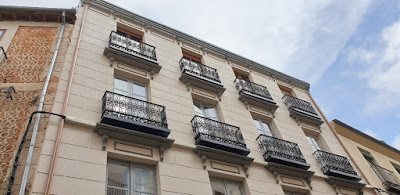Thank you to Javier Saez Frayssinet for sending these pictures of the nicest installation of integral Swift boxes that we have seen. Hopefully this will demonstrate to architects just what is possible with a little imagination.
In Javier's own words:
This is a story about a renovation of the facade and interior of a building located on Juan Bravo Street, within the historic city centre of Segovia.
A colony of Swifts nests every year on this facade. Under each balcony there was a corbel and the Swifts took advantage of the gaps between them.
When the renovation began, I was on vacation. When I returned to Segovia I found that scaffolding and a protective net had been installed.
I watched as the swifts tried to enter their old nests but the netting prevented it.
I contacted the local authorities and the owner of the building, who decided to lower the netting to the 2nd floor. As this new arrangement was not enough I spoke with the owner again and the netting was lowered further to the 1st floor where the swifts were not nesting.
The Swifts returned to their nests and successfully raised their chicks.
In order that in future years the swift colony would continue in the building, different alternatives were studied and it was decided to make nest places of plaster. The inside of each new corbel was divided into two parts with a plaster partition. The length of each nest chamber is 70cm, depth 17cm and height 15cm.
We think that it is a good solution for historic or modern buildings that have this kind of facade. The protection of a swift colony has been combined with the renovation of a historic building, resulting in a very pleasing solution.
Now we hope that when the swifts return at the end of April 2020, they will find the new homes we have built to be attractive.
 The realization of this project was possible because the architect, Carlos Martin, enthusiastically received our proposal to make the nests. The construction manager, Vinut Calmorot, installed the corbels and made entrances, using the formers that Dick Newell had sent us (for this project). The interior division meant that under each balcony there are two nests available for swifts.
The realization of this project was possible because the architect, Carlos Martin, enthusiastically received our proposal to make the nests. The construction manager, Vinut Calmorot, installed the corbels and made entrances, using the formers that Dick Newell had sent us (for this project). The interior division meant that under each balcony there are two nests available for swifts.In addition to the 16 Swift boxes that you see here, another 5 have been installed on the roof.
 |
| 16 Swift boxes |
 |
| How neat is that! |

















































